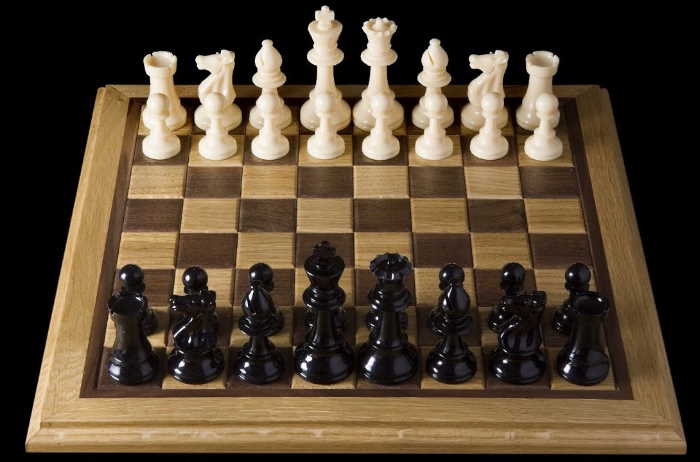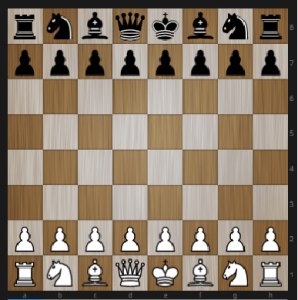Chess is an ancient game and has long been compared to a military battle. According to one of the legends, even the invention of chess is associated with the order of one ruler-commander who wanted to get a game, so to speak, a simulator of a real battle between two armies. And although living blood does not flow in chess, it is quite appropriate to imagine a chess player as a commander in command of an army of pieces in order to better understand the tricks of battles at the chessboard. And perhaps we should start from this very chessboard.
Chess board
Naturally, every commander must study the location and terrain where he will have to plan and conduct battles. It is easier for a chess player in this regard, because he will play all his fights on the same “terrain”, on a standard chessboard. But experienced players study this “terrain” thoroughly, remember literally by name the proper name of each cell, its color, they know where the hottest fight is likely to take place on the board, how and what pieces it is better to bring there …
Do not neglect the study of the chessboard!
The theater of military operations where you have to conduct chess battles is a square, in turn divided into black and white squares – fields. There are 64 fields in total, 32 white and 32 black.
Black and white fields alternate and, it would seem, the board is symmetrical, you can turn it as you like, nothing will change. But it’s not. Before starting the game, make sure that the left corner field closest to you is black.
Each field of the chessboard has its own name – coordinates. To do this, use the Latin letters a, b, c, d, e, f, g, h and the numbers from 1 to 8, written along the edges of the board like this:
The rows of 8 fields opposite each of the numbers are called horizontals, and the columns of 8 fields opposite each of the letters are called verticals. Accordingly, the horizontals and verticals are indicated by their number or letter. Horizontal 1, horizontal 2… or vertical a, vertical b, etc. Thus, each field belongs to one vertical and one horizontal, from which each field gets its name – coordinates. For example, a field located simultaneously on the vertical f and on the horizontal 4 has a name – the field f4. The fields of a chessboard of the same color, located on the same line are called diagonals.

More about the chessboard
Rules for moving pieces
Chess armies line up on the battlefield face to face. The forces of the parties before the battle are absolutely equal and the result of the battle depends only on the talent and knowledge of the commanders. Pawns line up in front of each army.
White has 8 pawns on the second rank and Black has 8 pawns on the seventh rank. Pieces line up behind the pawns.
In order not to confuse the queen and king, you should remember the simple rule “The queen loves her color”. Thus, the white queen should be placed on the white square, and the black queen on the black one. The side of the board where the kings are in the initial position is called the kingside, and where the queens are, the queenside.
Initial location on the diagram:
On a wooden chessboard:
The first move in a chess game is always made by White. A move is the movement of one piece from one square to another, free or occupied by an opponent’s piece.
And now let’s analyze how and what pieces make these moves, find out the capabilities of our soldiers.
Rook
The rook is a straightforward and powerful piece, the long-range artillery of chess, it can move any number of squares horizontally or vertically.
Elephant
The bishop is also a long-range piece, the chess archer can move any number of squares diagonally. It is easy to see that each bishop can move on squares of the same color, either only on white or only on black. On the field of what color in the initial position the bishop ended up, he will walk along the fields of the same color to the end. Therefore, elephants are called white-field and black-field, respectively.
Queen
The queen is the strongest piece, combining the capabilities of a rook and a bishop. Can move any number of free spaces in any direction in a straight line, horizontally, vertically, and diagonally.
Horse
The horse is the most cunning figure. If the rest of the pieces move straight along open lines, then the knight is not like that. The knight goes two squares straight horizontally or vertically in either direction, and sharply turns 900 in either direction. The diagram shows how the knight on b6 can move. He steps over squares b7 and b8, turns and stands on square c8. It turns out a route similar to the letter “G”. Therefore, it is easy to remember “The horse walks with the letter G.” And you can rotate this “letter” as you like. The diagram shows all the knight’s moves from the e5 square. It should be noted
during its course, the horse must go through the “letter G” from the beginning to the end, it cannot stop in the middle of the “letter”.
An interesting feature of the knight is the only piece that, after each move, changes the horizontal, vertical, diagonal and color of the field on which it stands.
Another trick of the knight, he can “take the barrier”, during his move “jump” over neighboring pieces. In the diagram, we see that the knight on b1 is surrounded by pawns and a bishop, and in order to make a move, it seems to have to wait until it is freed up for a move. This would be true for any other piece, but not for the knight. The knight easily overcomes the barrier and can, at the request of the player, jump to the squares a3 or c3, or d2
King
The most important and valuable figure. The goal of a chess battle is to capture the opponent’s king, to declare checkmate to him.
The king, like the queen, can move horizontally, vertically, diagonally in any direction, but only one field.
However, once per game, the king has the right to make a more frisky move, castling. If all the pieces standing between the king and the rook have left, and the king and the rook themselves have not yet made moves,
the king can move two squares towards the rook, and the rook “jumps” over the monarch, covering him with his broad back. This is how the position of the rook and king will look like after a short castling on the kingside:

And so after long castling on the queenside:
It must be remembered that, although both the king and the rook move during castling, according to the rules, castling is considered to be the move of only the king. Therefore, if you want to castle, you need to start it by moving the king two squares to the side, and then move the rook. You should not first push the rook towards the king, and then hide the king behind it. In this case, the opponent can say: “First you touched and moved the rook, move the rook, don’t touch the king.”
Castling is not possible:
- if the king or rook has already made moves during the game;
- if there is a piece between the king and the rook;
- if the square on which the king is located or the square that he must cross or occupy is attacked by an opponent’s piece.
If only the rook is attacked or crosses the square attacked by the opponent, castling is allowed.
Pawn
Pawns are ordinary soldiers, infantrymen of the chess army. With its characteristics, the pawn resembles an ancient Roman legionnaire. Alone, a legionnaire torn off from the formation, as a combat unit, is weak, but the formation, where the legionnaires support and protect each other, can sweep anyone out of their way. In battle, the phalanx of legionnaires is doomed to move only forward. If other types of troops, cavalry, archers, can maneuver, move back, to the side, then the formation of legionnaire infantrymen always slowly and inevitably moves directly towards the enemy. To turn, retreat, means to break the system and die.
The pawn must also move only forward. From the initial position to two or one field, at the request of the player, with the next moves – only to one field. In the diagram, the pawns a2 and b2 are in their initial positions and can go to two squares or one. The a2 pawn is on the a3 or a4 square, and the b2 pawn is on the b3 or b4 squares. It can be seen that the rest of White’s pawns have already moved, so they can only move one square. The c3-pawn can go to the c4-square, the g6-pawn to the g7-square, the h5-pawn to the h6-square.
A pawn, unlike other pieces, simply has a different move and a move with a capture. Again, remember the Roman legionnaire. Covered with a wide heavy scutum shield and armed with a short gladius sword, the legionnaire stabbed not directly in front of him, but obliquely from the shield, forward and sideways. The pawn also attacks forward and sideways, diagonally one square. In the diagram, the pawn on d4 rested its shield against the shield of the black pawn on d5 and cannot hit it, but it can mortally sting the knight on c5. The pawn on g6 can pierce the rook on f7 or the black pawn on h7.
As we can see, the black e7 pawn is in its initial position, and therefore has the right to move two squares forward, to e5. She has something, but the e6 square is under attack by the white pawn f5, and it is fraught for infantrymen to run across the fields located in the zone of action of the enemy sword. In this situation, the white f5-pawn can capture the black pawn that has run past, and itself move to the e6-square. Such a capture is called an aisle capture. Such a capture is possible only immediately, in response to the dash of the enemy pawn.
When a pawn, having overcome all dangers, reaches the horizontal, it, at the request of the player, turns into any piece except the king. In the vast majority of cases, the pawn is promoted to the most powerful piece, the queen.
